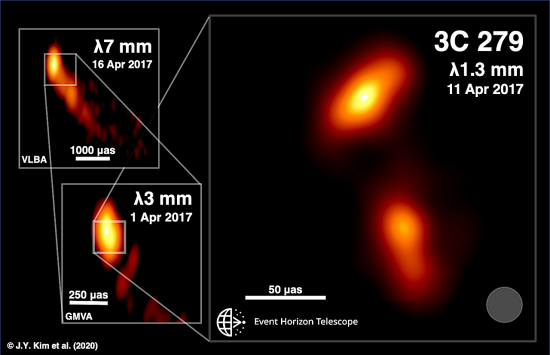
April 8, 2020
Another relativistic jet attributed to a black hole.
“A professional tends to interpret the pictures by using the theory he was taught while the amateur tries to use the picture to arrive at a theory.”
— Halton Arp
According to a recent press release, collimated jets erupting from quasar 3C 279 are the result of matter falling into the gravity field of a black hole. As galactic matter orbits closer to the putative black hole, it accelerates, causing violent collisions among the jet’s particles. Those collisions are said to generate X-rays and other high frequency radiation. Somehow, that acceleration creates a powerful filamentary jet.
Astronomers often detect ionized particles and X-rays erupting from various stars. Explaining them remains one of their most difficult tasks. As mentioned, dust and gas are supposedly energized by collisions as they orbit within a black hole’s accretion disk. Gas and dust grains heating up as they orbit does not address the jets. There is only one force that can hold a matter stream together over long distances: electromagnetism. The only way to generate that electromagnetic confinement is with electricity.
On the other hand, as the announcement points out, astronomers do not understand extragalactic jets. Since more than 99% of the visible Universe is in the plasma state, created by ionizing hydrogen and helium: electron–ion plasmas are ubiquitous. The two lobes of 3C 279’s radio jet are cones of plasma viewed from the side. They illustrate a galaxy-scale dense plasma focus or “plasma gun”. Surrounding the central bulge is what should more properly be called an “expulsion disk” rather than an “accretion disk”.
Standard cosmological theories are hard-pressed to match models with observations. X-rays from ion excitation, radio waves, and (sometimes) gamma-rays are all properties of lightning bolts. Since plasma phenomena are scalable over many orders of magnitude; they act the same whether they are in atoms or in galaxies. The plasma gun effect occurs when an electric current in plasma generates a magnetic field that constricts the flow of charge. The constricted channel is known as a Bennett pinch, or z-pinch. The “pinched” filaments of electric current remain coherent over large distances, spiraling around each other, forming helical structures that can transmit power through space.
That factor probably explains why the research team discovered that “…the normally straight jet has an unexpected twisted shape at its base and, revealing features perpendicular to the jet…”
As written before, failing to realize that electric charge creates magnetic fields has led many physicists to model plasma in space without considering electricity. Nobel laureate Hannes Alfvén noted that plasma is “too complicated and awkward” for the tastes of mathematicians. It is “not at all suited for mathematically elegant theories” and requires laboratory experiments.
Alfvén observed that the plasma Universe had become “the playground of theoreticians who have never seen a plasma in a laboratory. Many of them still believe in formulae which we know from laboratory experiments to be wrong”. He thought that the underlying assumptions of cosmologists “are developed with the most sophisticated mathematical methods and it is only the plasma itself which does not ‘understand’ how beautiful the theories are and absolutely refuses to obey them”.
Stars (and galaxies) are nodes in electric circuits. Their electromagnetic energies could be stored in the equatorial current sheets surrounding them until some trigger event causes them to switch into a polar discharge. The electric jet could receive its energy from a natural particle-accelerator, a plasma double layer with a strong electric field. Toroidal magnetic fields would form because of the polar plasma discharge, confining it into a narrow channel.
Stephen Smith
The Thunderbolts Picture of the Day is generously supported by the Mainwaring Archive Foundation.












